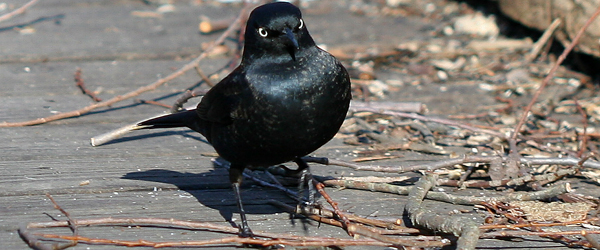Do you live in the southeastern United States (broadly defined)? Are you a birder? Then you should be helping count Rusty Blackbirds (Euphagus carolinus) right now! Over the last forty years Rusty Blackbird populations have cratered, dropping between 85% and 98%. Obviously, something is drastically wrong and the Rusty Blackbird Working Group and eBird have teamed up to gather data from February 7-15 that will, hopefully, help shed light on what is going on with Rusty Blackbirds.
But doing bird surveys is hard and figuring out what data is needed is impossible for an amateur, right? Wrong! Simple instructions are on the eBird page that describes the survey and a partial excerpt is below:
If you encounter Rusty Blackbirds, be sure to record the number of birds (flock size) and how you generated that number (estimate vs. direct count of individual birds). It is also highly recommended that you record the following information relating to your observations of Rusty Blackbirds, if you are able to do so:
- Number of males and females
- Habitat where encountered: field, lawn, forest, impoundment (with or without trees), river/creek/lake edge, pecan farm, other (specify). You may also provide your own habitat description
- Ground wetness: dry, moist, patchy flooding, fully flooded
- Behavior: feeding on ground, feeding in trees or shrubs, feeding in water, loafing, staging to roost, roosting, or flying. If feeding, any information on food items would be helpful
- Vocalization: call notes, song, both, neither
In addition to Rusty Blackbird data, recording the following information is preferable if it is possible to do so. Record each species encountered (numbers for each species are also appreciated). For all blackbird species, record the number of birds (flock size) and how you generated that number (estimate vs. direct count of individual birds).
I for one, think Rusty Blackbirds are great birds and have fond memories of seeing and hearing flocks of them refueling on their northward migration at Papscanee Island and seeing breeding pairs in the Adirondacks. It would be horrible if they continued to decline and their squeaky rusty gate call was only heard when opening a rusty gate. Do you need another reason to do the survey? How about the fact that no one else is?
The decline, although one of the most profound for any North American species, is poorly understood. Moreover, no conservation or monitoring programs exist for this species…Given the species close association with wooded wetlands throughout the year, it could prove to be an excellent indicator species for environmental processes in these threatened ecosystems.
So get out there and find and count and report your sightings! A species is declining and you are needed to help find out why!














Leave a Comment